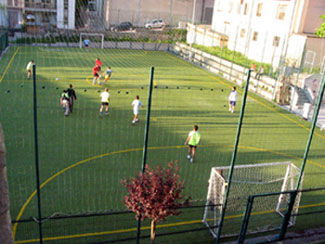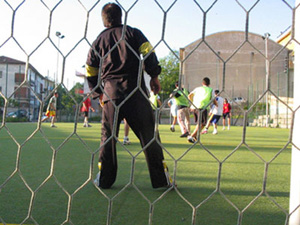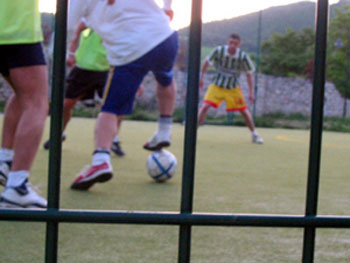 |
If you had walked by Caffé d’Italia on the
night of Wednesday, May 25th, you would have realized
it was the place to be in the small, hillside village
of Cagli.
There, a quite peculiar congregation of men and women
of all ages — from nine-year-old kids to people in their
eighties — laughed, cried, jumped, fell on their knees
and finally dropped to their heads sinking into melancholy.
|
|
|
|
 |
The Cagli Soccer Field |
|
Only one thing could paralyze the Italian people like that:
a soccer game.
The obsession with soccer is so alive in Italy that some
believe it is the strongest it has ever been.
“Soccer is part of everyday life in Italy,” said Silvano
Bucci, a resident of Cagli in the Marche region and owner
of Caffé d’Italia. “We talk about soccer everyday.
It is a common subject in the streets; it is a way of socializing.”
“Italy
equals spaghetti and soccer.”
Today’s Italian soccer fans grew up in a beautiful era
of Italian soccer history, full of enjoyment and triumphs.
Among other great victories, they experienced the ultimate
conquest during the 1982 World Cup Tournament, with heroic
figures such as Paolo Rossi, the leading scorer of that
year’s event.
|
|
Italy’s enthusiasm for soccer began at a very
early stage of the sport. It took only two World Cup Tournaments
for the Italians to earn the championship title in 1934.
The legendary Angelo Schiavio, who was to become the leading
scorer of that year’s tournament, led the team. This success,
repeated in 1938, set off a fever among the population that
still occupies a large part of their lives.
The A.C. Milan team of the late 1980s — dubbed the “unbeatable
team” — won multiple titles. Franco Baresi, who would be eventually
voted as “A.C. Milan’s Player of the Century,” was team captain.
A.C. Milan fans also had the pleasure of witnessing the spectacular
skill of such great players in the global history of soccer
as the Dutch trio of Marco Van Basten, Ruud Gullit, and Frank
Rijkaard. They made the Italian people, especially A.C. Milan
fans, go crazy for the sport. |
 |
A Player in Goal
|
|
|
 |
Players on the Field
|
|
“Soccer is like a goddess to me,” explained
Marco Mezzolani, a Cagli resident and soccer player.
Mezzolani, with his baggy pants and big shirts, is a tremendously
outgoing and enthusiastic individual who is renowned as a
professional graffiti artist, former break-dancer, passionate
writer, reader, and one of the most known and representative
figures of the Cagliese pop culture. But most of all, he is
a huge soccer fan.
Just when you thought you knew everything about Mezzolani,
someone mentions A.C. Milan, and Mezzolani’s eyes open wide.
The team represents one of his deepest passions. As you dig
into it, you discover that nothing would be complete in his
life without the striped black and white of the A.C. Milan,
specifically, and Italian soccer in general.
“Italy equals spaghetti and soccer,” explains Mezzolani’s
brother, Roberto. “We like soccer because it is a symbol of
liberty and healthiness.” For the Italians, soccer is more
than just a game; it is a lifestyle. " |
|
In Cagli for example, Mezzolani and his brother
Roberto meet every Thursday night at the Campeto, a soccer
field in the town, to enjoy a competitive game among friends
that could last for over two hours.
“It is good and fun to play with your friends,” said Roberto
Mezzolani. Marco Mezzolani has traveled thousands of miles
to Istanbul, Turkey, in order to support his beloved team
on the same night many of the people in his town gathered
at Caffé d’Italia — May 25.
“Soccer
is part of everyday life in Italy,we talk about soccer everyday.
It is a common subject in the streets; it is a way of socializing.”
On that date A.C. Milan played Liverpool, England, for the
Champions’ League championship. It was a night full of emotion.
Milan started the game strong and by halftime, they were on
top 3-0.
“We were celebrating; we thought we had them,” Mezzolani
remembered. Meanwhile the people in Cagli were cheering and
drinking in preparation for the anticipated celebration. However
good fortune would not remain on the Italian side, and in
the second half, the young Liverpool team found a breather
that gave them energy and hope. They eventually tied the game
at 3-3. |
 |
A Game in Progress
|
|
|
| |
“I saw it coming,” Mezzolani said. “Milan stopped
playing when Liverpool came all over us: the adrenaline was
unbelievable.”
At the end of the regular 90 minutes, the score was 3-3,
sending the teams into two additional overtime periods. The
score still remained tied after OT, sending the game to penalty
kicks.
During the penalty kicks, drama overshadowed the Italian
side while many suffered on their knees in the Caffé d’Italia.
Finally, A.C. Milan needed one score to prolong the game.
But on the ninth penalty, A.C. Milan’s striker Shevchenko
kicked the ball into the hands of the Liverpool goalkeeper
Jerzy Dudek, lifting the English team to glory and dropping
the Italians like Mezzolani to misery. “I cried and cried,”
he said. |
|
|
|

